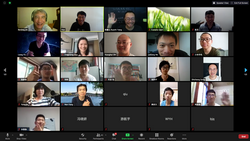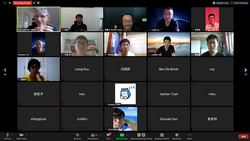2020 Fudan Logic Summer School
A small test lecture will be given by Renling Jin on Aug 8 at 8:58 AM (GMT+8). The topic is proving Kőnig's lemma using nonstandard method. Zoom Meeting ID: 662 203 94055, Password: 202003. Slides
Time: August 10 - August 21, 2020
Location: Zoom Meeting
Zoom Meeting ID: To be send via email according to the registration
Hours for the first week (Aug 10 - Aug 14):
- Lecture1: 9:00 - 10:15 (GMT+8)
- Lecture2: 10:45 - 12:00 (GMT+8), 10:30 - 11:45 (GMT+8) starting from Aug 11
- Section: 14:00 - 16:00 (GMT+8)
Hours for the second week (Aug 17 - Aug 21):
- Lecture 1: 15:30 - 17:00 (GMT+8), 14:30 - 16:00 (GMT+8) starting from Aug 18
- Lecture 2: 17:30 - 19:00 (GMT+8), 16:15 - 17:45 (GMT+8) starting from Aug 18
- Section: (Next day) 9:30 - 11:30 (GMT+8)
The first week (Aug 10 - Aug 14): Nonstandard analysis (Renling Jin 金人麟, in Chinese)
The second week (Aug 17 - Aug 21): Set theory - Forcing axioms and the $\mathbb{P}_\mathrm{max}$ axiom ($\ast$) (Ralf Schindler)
力迫法讨论班:
-
7.17 - 7.20,张体云,每天下午14:30 - 16:30,腾讯会议ID:352 5436 9473
-
7.22,陈泽晟,下午14:00 - 16:00,腾讯会议ID:352 5436 9473 Slides
- 7.31, 8.6,吴刘臻,力迫迭代,下午14:00 - 16:00,腾讯会议ID:352 5436 9473。参考资料:T. Jech, Set Theory (The Third Millennium Edition), Chapter 16, 31, 37.
Introduction to nonstandard analysis
The lectures will introduce the concept and some applications of nonstandard analysis. The main characteristic of nonstandard analysis is that the extended system of reals containing infinite and infinitesimal elements still satisfies the same first-order statements with the standard system. Working in a framework of reals containing infinite and infinitesimal elements sometimes brings simplified or more intuitive presentation of a problem, sometimes simplified the proof and even makes unknown theorem more accessible. The objective of the lectures is to introduce nonstandard analysis as a mathematical instrument, so that the audiences may apply it in the areas interest them and exploit its potentiality. We will neglect most of the historical account of nonstandard analysis. Audiences who are interested in these part can find the discussion in the references below. There are five lectures. The first lecture introduce the concept and logic backgroud of nonstandard analysis. The next four lectures introduce the applications of nonstandard analysis in other area of mathematics. The extent of the applications of nonstandard analysis is much wider than these lectures may cover. The selection of topics is based on personal preference of the lecturer. Audiences interested in the applications in other areas are also directed to the references below. The lecturer will provide exercises after every lecture, which may enhence one's understanding of the subjects.
The lectures will be in Chinese. Lecture Notes (Aug 15,2020 modified)
Reference:
- N. J. Cutland, C. W. Henson, and L. Arkeryd, editors, Nonstandard Analysis: Theory and Applications, Kluwer Academic Publishers 1997.
- R. Goldblatt, Lectures on the hyperreals–an introduction to nonstandard analysis, Springer, 1998.
- 金人麟,非标准分析及其应用,《中国科学·数学》2016 年第 46 卷,第 4 期,371 – 408.
- P. Loeb and M. Wolff, editors, Nonstandard Analysis for the Working Mathematician, Second edition, Springer Netherlands, 2015.
Program:
- Day 1: Nonstandard Extensions of the Real field and Hyperreal Structure Slides Video: Bilibili Youtube
- Day 2: Nonstandard Analysis and Calculus Slides Video: Bilibili Youtube
- Day 3: Nonstandard Analysis and Measure Theory Slides Video: Bilibili Youtube
- Day 4: Nonstandard Analysis and Stochastic Process Slides Freiman's Inverse Problem Video: Bilibili Youtube
- Day 5: Nonstandard Analysis and Combinatorial Number Theory Slides Video: Bilibili
Lecturer:
Renling Jin 金人麟 is a professor at the Department of Mathematics, at College of Charleston. His main research interests are among nonstandard analysis, additive-combinatorial number theory, set theory, model theory, measure theory, general topology. Prof. Jin has published articles in Journal of Symbolic Logic, Advances in Mathematics, The Transactions of American Mathematical Society, and many others.
Forcing axioms and the $\mathbb{P}_\mathrm{max}$ axiom ($\ast$)
Forcing axioms are generalizations of Martin's axiom to larger classes of forcing. The strongest forcing axiom, introduced by Foreman-Magidor-Shelah, is Martin's Maximum. It formalizes the maximality maxim, formulated by Magidor: "If a mathematical object can be imagined in a reasonable way, then it exists!" Another maximality principle is the axiom ($\ast$), introduced by Woodin, which is $\Omega$-complete with respect to statements which are $\Pi_2$ over $H_{\omega_2}$. Both forcing axioms and ($\ast$) produce a rich analysis of (rank initial segments of) the universe of sets. We will explore this exciting area and give a proof of the recent result, due to Asperó and the speaker, that Martin's Maximum${}^{++}$ implies ($\ast$).
Lecture notes produced by Jiaming Zhang with help of Prof. Ralf Schindler can be found on Ralf Schindler's personal website.
Suggested reading material:
Please note reading the following material is NOT a mandatory prerequisite.
- 陈泽晟, Magidor Characterization of Supercompactness and Generic Ultrapower.
- T. Jech, Set theory (The Third Millennium Edition), Chapter. 31, pp. 420 (middle) to 421, pp. 424 to 427 (middle), pp. 601-608, and Chapter. 37, pp. 681-685.
- Ralf Schindler, Set theory: Exploring independence and truth, Problem 4.29 on p.65, pp.50 (middle) to 57 (middle), and Definition 4.62 on p.59.
- Paul Larson, Forcing over models of determinacy, chapters 1-6.
- David Aspero and Ralf Schindler, Martin's Maximum++ implies Woodin's Axiom (*).
- Benjamin Claverie and Ralf Schindler, Woodin's axiom (*), bounded forcing axioms, and precipitous ideals on omega_1.
Program:
- Day 1: Recapitulation of the forcing technique, proper, semi-proper, and stationary set preserving forcings. The Proper Forcing Axiom and Martin's Maximum. Video: Bilibili Youtube
- Day 2: Iterated forcing and reflection principles. The consistency of Martin's Maximum. Martin's Maximum implies that there are $\aleph_2$ many real numbers. Video: Bilibili Youtube
- Day 3: $L$-forcing and $\Pi_2$ consequences of Martin's Maximum. Video: Bilibili Youtube
- Day 4: The Axiom of Determinacy and $\mathbb{P}_\mathrm{max}$ forcing. The key analysis of the $\mathbb{P}_\mathrm{max}$ extension of $L(\mathbb{R})$. The axiom ($\ast$). Video: Bilibili Youtube
- Day 5: A proof that Martin's Maximum${}^{++}$ implies ($\ast$). Video: Bilibili Youtube
Lecturer:
Ralf Schindler is a Professor at Fachbereich Mathematik und Informatik, at Universität Münster. His research interest is set theory. Prof. Schindler has published many papers in Journal of Mathematical Logic, Journal of Symbolic Logic, Notre Dame J. Formal Logic, and many others.
2020复旦大学数理逻辑暑期学校由复旦大学教务处主办,复旦大学哲学学院逻辑学教研室承办

